To Italy!
Find out more about Max Liebermann’s eventful relationship with Italy and its cultural landscape!
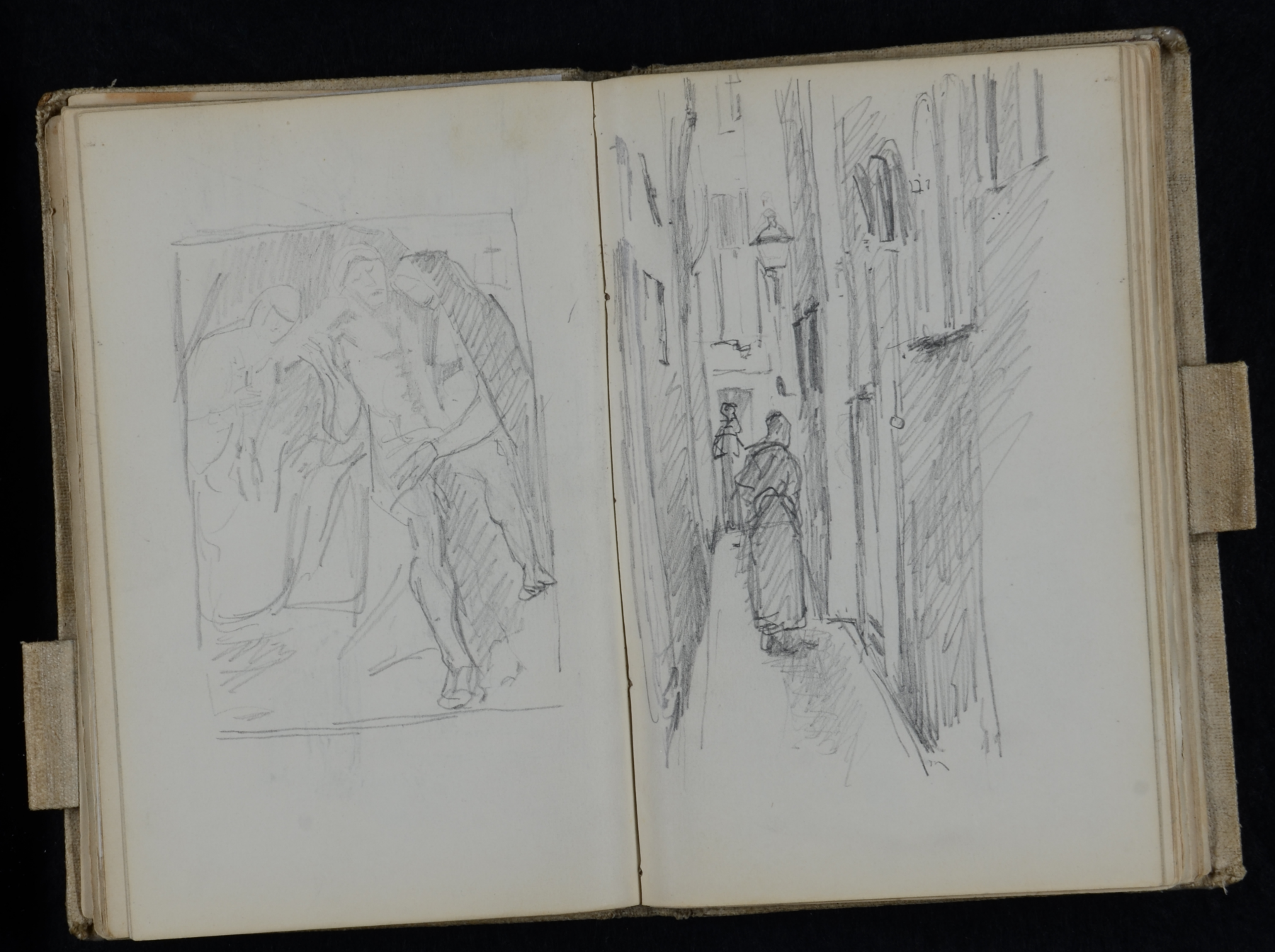
The first Italian sketchbook
The sketchbook exhibited here offers insights into Liebermann’s first stay in Italy in 1878.
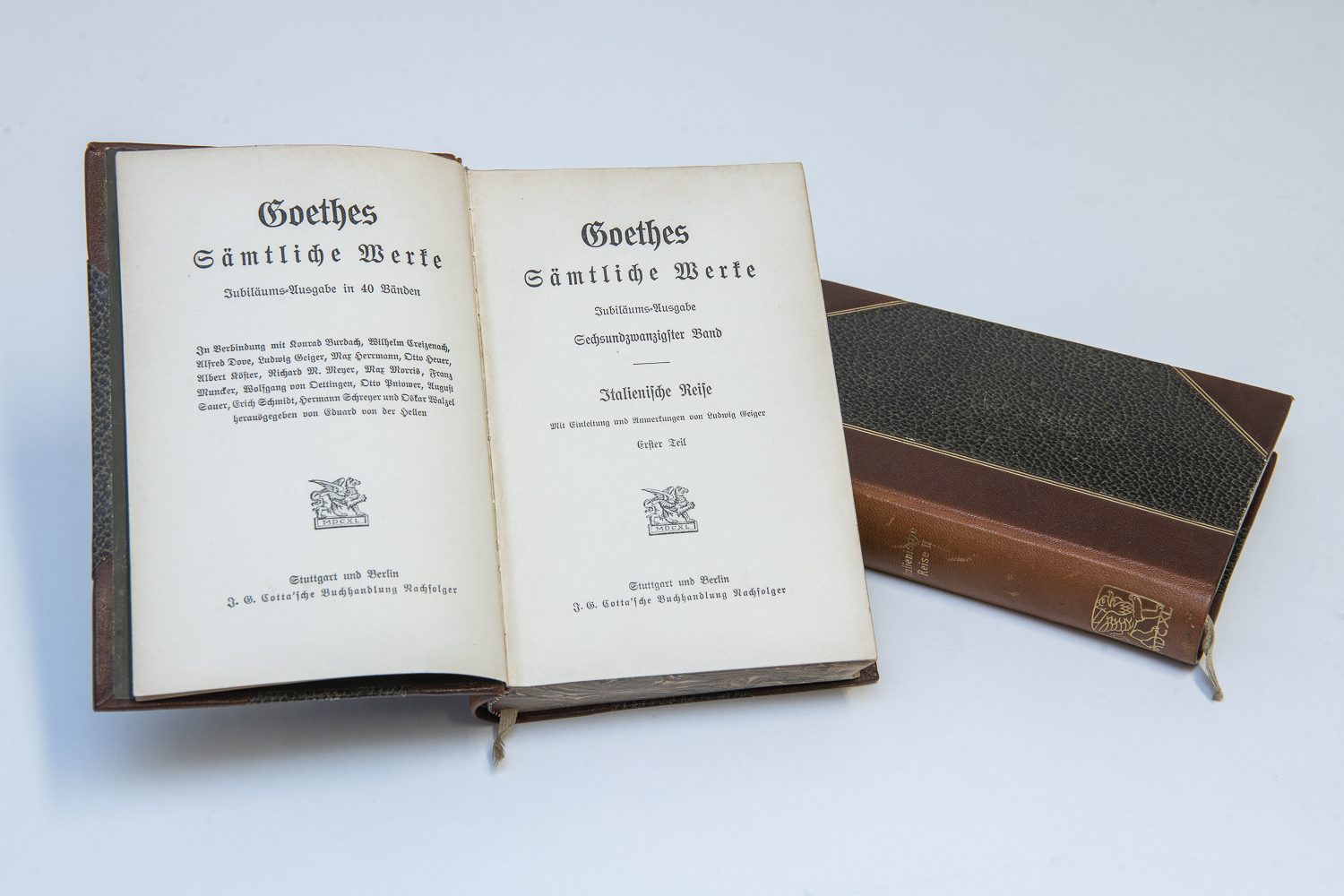
Goethe's Italian Journey
Max Liebermann was a great admirer of Johann Wolfgang von Goethe. This 40-volume anniversary edition of Goethe’s complete works comes from the estate of Max and Martha Liebermann.
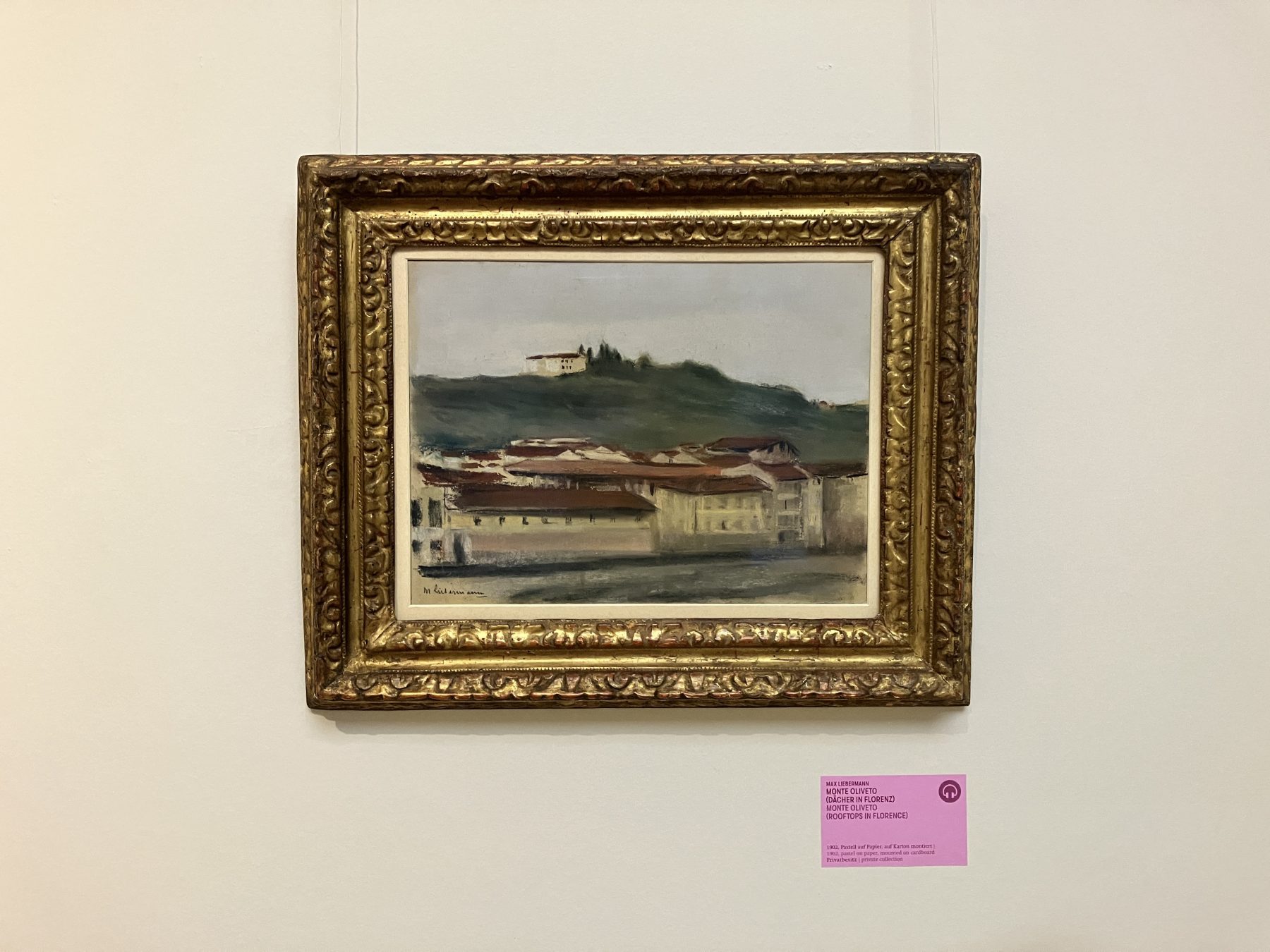
Views of Florence
Max Liebermann’s pastels of Florence are considered to be his main Impressionist works.
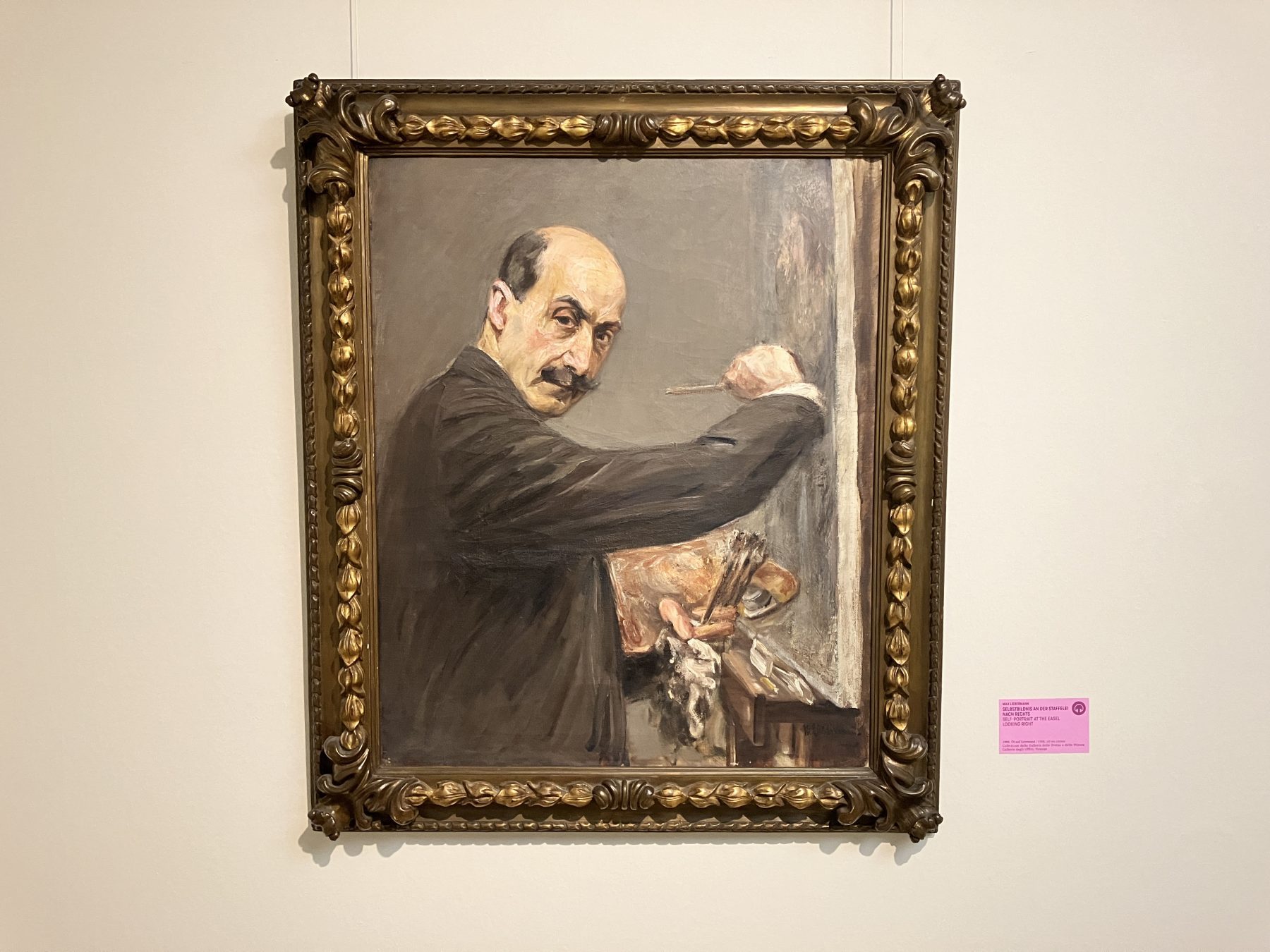
The self-portrait for the Uffizi
In May 1908, the directors of the Uffizi commissioned Max Liebermann to paint a self-portrait for their portrait collection.
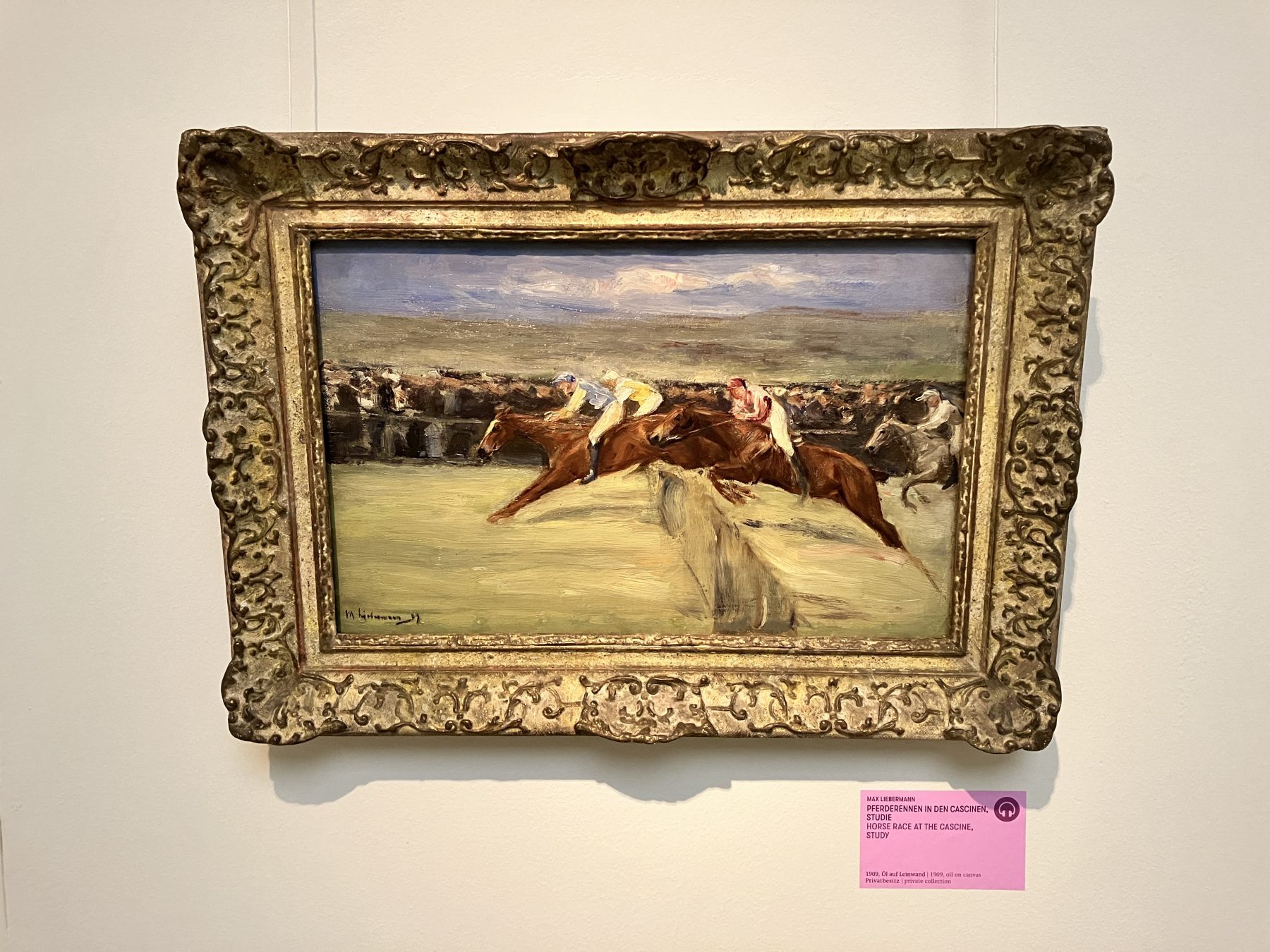
Horse race in the Cascine Park
Here you can see a study of horse racing in the Cascines from 1909.
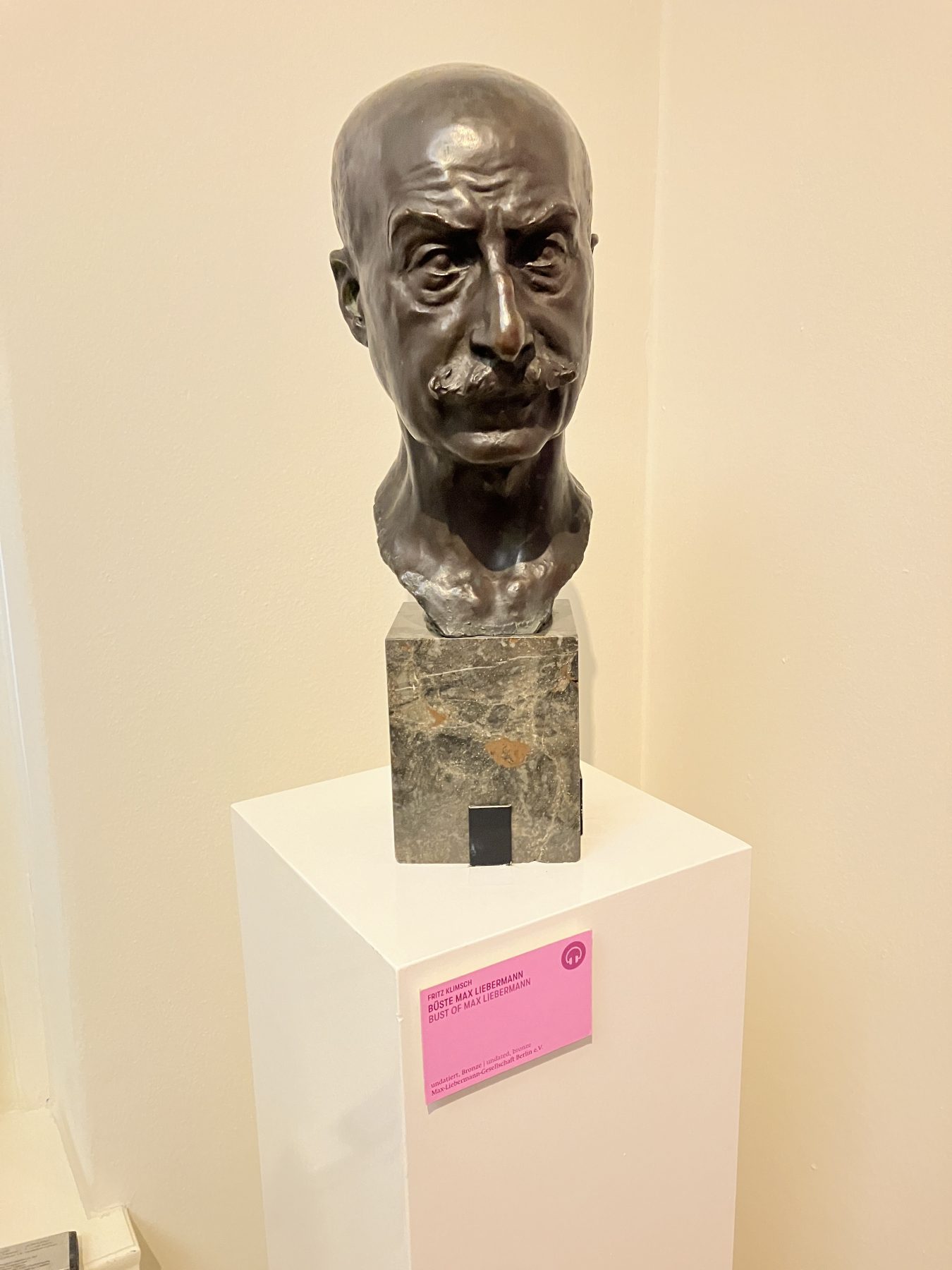
Liebermann's bronze bust
The sculptor Fritz Klimsch made the preliminary drawing of this portrait bust during a dinner at Liebermann’s home.
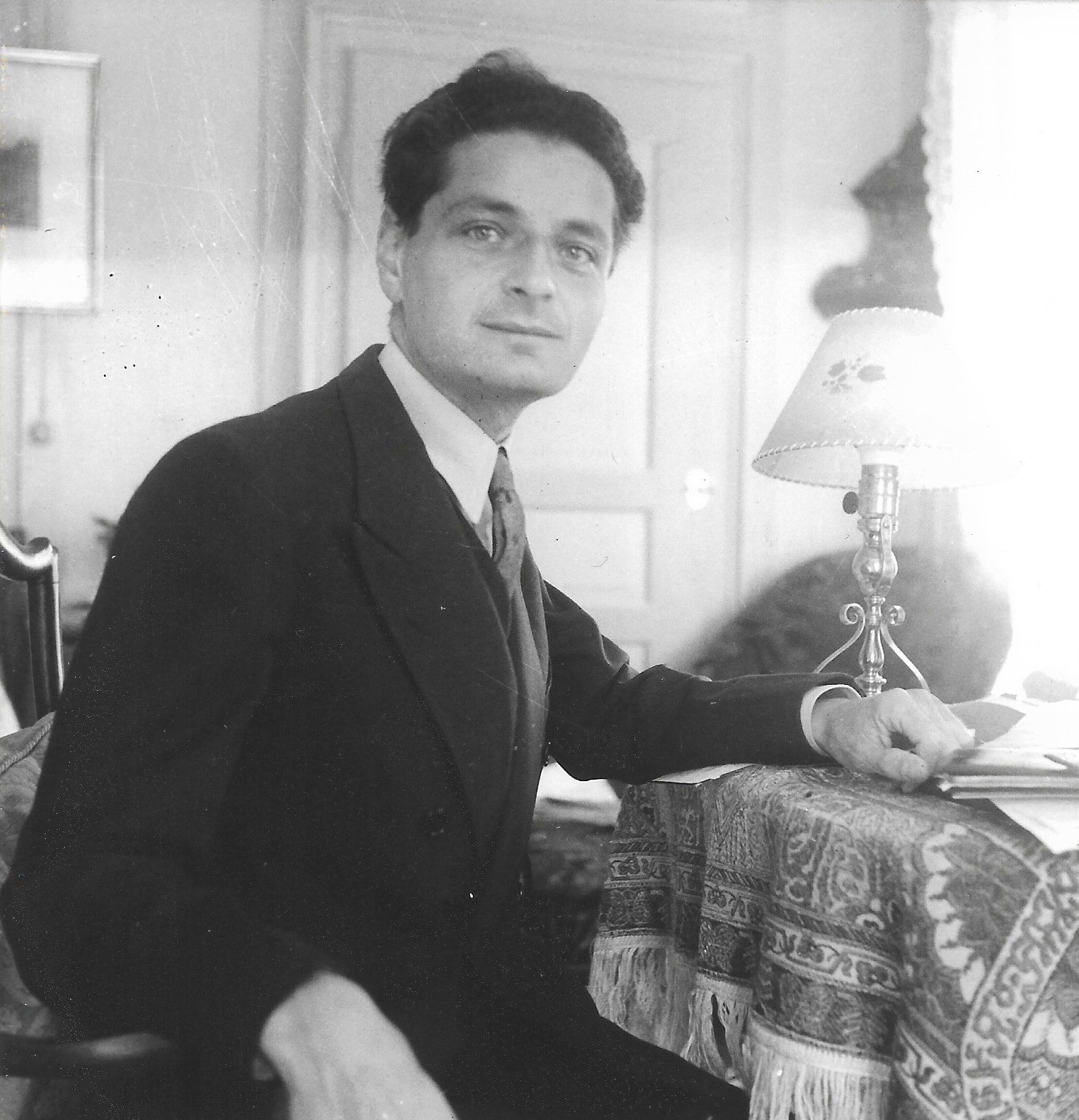
Correspondence with Guido Lodovico Luzzatto
The Milan critic Guido Lodovico Luzzatto first came into contact with Max Liebermann in 1931.
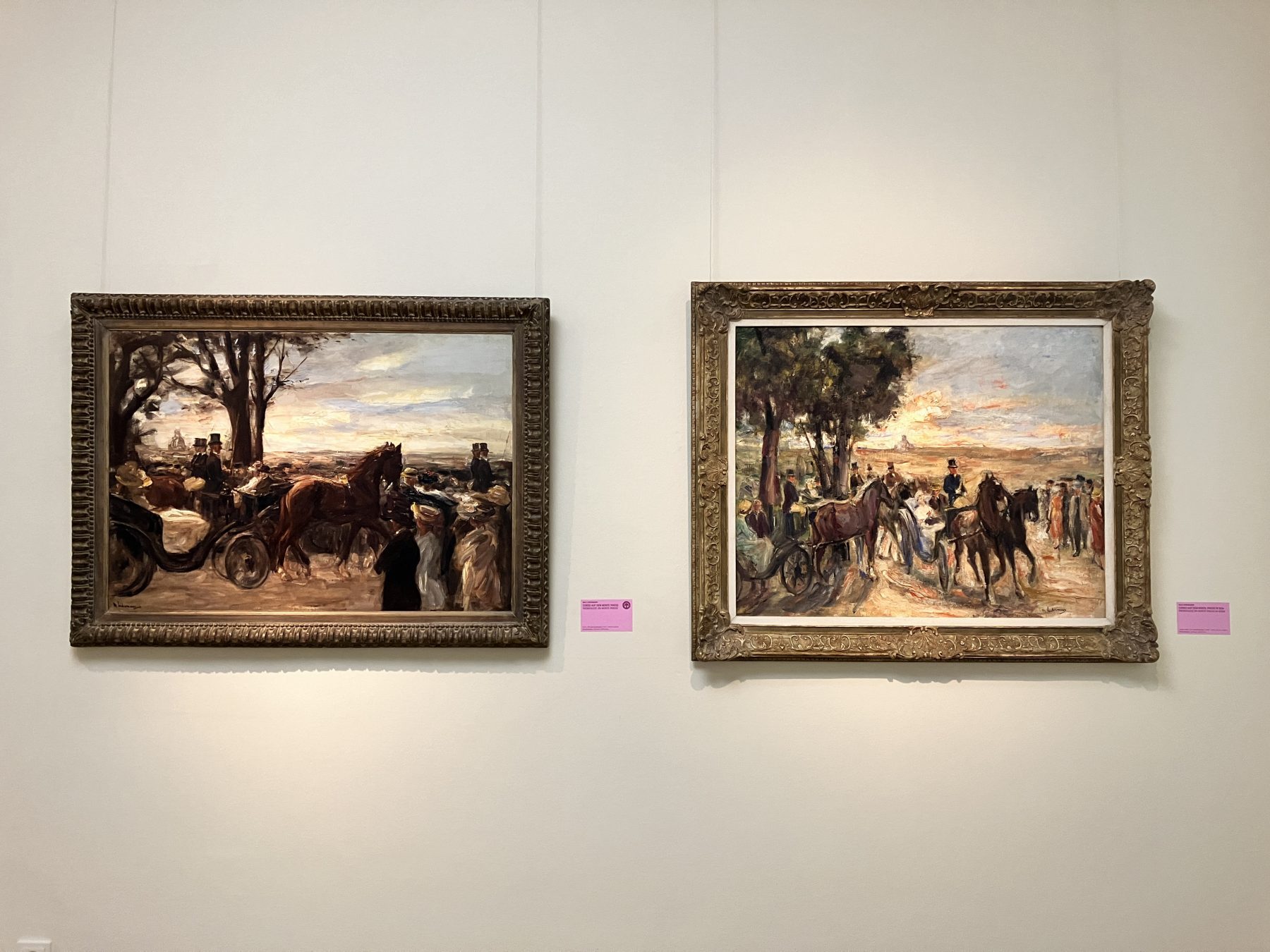
Promenade on Monte Pincio
On warm evenings, Monte Pincio was a popular place for upper-class Roman families to hold their parade, i.e. to parade their carriages with their horses and show them off.
Production
Texts, editing: Alice Cazzola
Production: Studio Brod, Berlin
ENGLISH WALL TEXTS
To Italy! With Liebermann in Venice, Florence and Rome
How is Max Liebermann (1847-1935) linked to Italy? This question opens up a lesser-known aspect of Liebermann’s life and work, one that has been largely overlooked in existing research. For decades, the Netherlands was the Berlin painter’s preferred travel destination and an important source of inspiration. France also played an important role for Liebermann, who moved to Paris after his studies in Weimar and familiarized himself with modern French art as a collector.
Unlike his fellow German-speaking artists of the older generation, Liebermann avoided the obligatory educational trip to Italy for a long time. It was not until 1878 that he crossed the Alps to travel to Venice. Some of his statements suggest a sometimes negative attitude towards Italy: In contrast to his self-proclaimed “painting homeland” of Holland, he described Italy as “too picturesque” and even described himself as a “hardened anti-Italian” in the early 1890s. In the 1910s, his biographer Erich Hancke claimed the following about Liebermann’s relationship with Italy: “The artist, who had a thoroughly Nordic sensibility, lacked a sense both for nature and for the art of the country.”
However, these quotes diminish the actual significance of Italy for Liebermann. From the late 1870s onwards, the artist made at least six trips to Italy. While there, he encountered the Italian art scene and found inspiration for his own works. He took up numerous Italian motifs in his works and took part in international exhibitions in the Kingdom of Italy. This exhibition presents Liebermann’s Italian connections for the first time.
Venice
Max Liebermann undertook his first trip to Italy at the age of 31. He was living in Paris at the time and had broken his foot during a visit to his parents in Berlin. In the summer of 1878, he traveled to Bad Gastein for a cure and from there via Tyrol to Venice, where he arrived in October.
Liebermann spent two months in the lagoon city. During this stay, he produced around ten oil paintings as well as numerous watercolors and drawings. However, they did not depict famous sights such as St. Mark’s Square or the Grand Canal, but everyday scenes. One of his sketchbooks from this trip has survived and is on display here.
From 1895, The first International Art Exhibition of the City of Venice turned the city into a hub for art lovers from all over the world. Liebermann supported the venetian Art Biennale from the very beginning: He was a member of the international patronage committee and presented his works at a total of eight times. The painting Brabant lace makers, which you will find in this room, was shown at the second Biennale in 1897. At the end of the exhibition, the painting was donated to the Galleria Internazionale d’Arte Moderna in Venice – the first Liebermann work to enter the collection of an Italian museum.
It was not until 24 years later, in 1902, that Liebermann, now a family man, was back in Venice. He stayed at the Grand Hôtel Britannia on the Grand Canal with his wife Martha and 17-year-old daughter Käthe. During this visit, the painter – continuing to ignore the typical vedute – created several views of the city and met with Venetian colleagues in churches and museums.
Liebermann’s Italian sketchbook
During his artistic career, Max Liebermann filled hundreds of sketchbooks, of which only eleven are still known today. The sketchbook from 1878 not only documents the everyday life of the Tyrolean rural population, but also Liebermann’s impressions of Venice. Instead of the expected vedute, the book contains sketches of the Venetian population, architectural and figurative details, isolated copies and notes such as names and addresses. The sketchbook also shows studies of the interior of the Sephardic synagogue Scuola Levantina and a sketch for the painting The Twelve-Year-Old Jesus in the Temple (1879), which takes a scene from the Bible as its subject.
Florence
After his first stay in Venice in 1878, Max Liebermann did not travel to Italy again for 15 years. He had moved from Paris to Munich and then returned to his hometown of Berlin, where he started his own family and continued to establish himself as an artist. It was not until the spring of 1893 that Liebermann crossed the Alps for a second time. From mid-April this year, he spent several weeks in Florence with his wife Martha and their then seven-year-old daughter Käthe. Together they visited the many sights of the city as well as the art collections of the Uffizi and Palazzo Pitti. Back in his Berlin studio at the end of May, Liebermann painted a fuller’s workshop in Florence, which is exhibited in this room.
Nine years later, in mid-September 1902, Liebermann embarked on a third trip to Italy accompanied by his family. From his room in the Grand Hôtel de la Ville in Piazza Manin (now Piazza Ognissanti), he captured the view of the rooftops of Florence.
In 1908, the painter visited the city on the Arno for the last time. On this trip, he discovered the horse races in the Parco delle Cascine. In the same year, he was commissioned by the director of the Uffizi to paint a self-portrait for the museum’s renowned portrait collection. Back in Berlin, Liebermann immediately set to work. The portrait is still in the Uffizi collection today and shows him painting at the easel.
Goethe’s Italian Journey
Italy had been a place of longing for German-speaking cultural figures since the Renaissance. At the latest after the publication of Johann Wolfgang Goethe’s Italian Journey, Italy became an unavoidable travel destination for the educated middle classes.
The two-part work is based on Goethe’s stories in his diaries, which he took with him on his almost two-year journey through Italy between 1786 and 1788 and in which he recorded his observations and experiences. After ten years at the Duke’s court in Weimar, the poet set off for the south in September 1786: He traveled via Padua, Venice, Bologna and Perugia, among other places, to Rome, where he stayed for four months. There he stayed with his painter friend Johann Heinrich Wilhelm Tischbein in Via del Corso 18, today’s Casa di Goethe, which has housed a Goethe Museum since 1997 – our cooperation partner for this project. Goethe then traveled further south to reach Sicily via Naples and Pompeii.
In March 1788, Goethe made his way home. He traveled via Siena, Florence, Parma and Milan back to Weimar, which he reached in May of the same year. It was not until much later, from 1813, that Goethe revised his travel diaries for publication. The first editions of the Italian Journey were published in 1816 and 1817.
Max Liebermann was a great admirer of Goethe. He described himself as an “enraged Goethean” and often quoted from his writings. A letter that Liebermann wrote from Florence in 1893 begins with the emphatic exclamation: “Anch’io in Italien!” (“I too in Italy!”). With this, the painter makes direct reference to the statement “Auch ich in Arkadien!” (“I too in Arcadia!”), which Goethe prefaced his Italian Journey.
The Liebermann Villa keeps the 40-volume anniversary edition of Goethe’s Complete Works from the estate of Max and Martha Liebermann in its collection. This edition was published between 1902 and 1912 and naturally includes the Italian Journey. In our audio guide, you can hear more about the history of these volumes and how they came to be in our museum collection.
In Italy with Max Liebermann
Max Liebermann traveled extensively in Germany and abroad. Between 1871 and 1913, he visited the Netherlands almost every year, lived in Paris between 1873 and 1878 and then repeatedly traveled to France. Until 1913, he also spent at least four times in Switzerland, three times in Austria-Hungary and once in the United Kingdom. Between 1878 and 1913, he traveled to Italy at least six times.
After Liebermann made his first trip to Italy alone, the next trips followed in the company of his wife Martha and his daughter Käthe. Liebermann visited the cultural sites of Venice, Florence, Rome and Naples. He sketched his impressions and continued to paint them in oil, often in his Berlin studio. Liebermann’s Italian travels are depicted on the map in this room. His works of art were also regularly exhibited in Italy during his lifetime. The first public presentation took place in 1895, at The first International Art Exhibition of the City of Venice – the prelude to the world-famous art biennale. Liebermann’s pastel portrait of Gerhard Hauptmann from 1893 was shown here. He was awarded the International Prize of the Province of Venice for this outstanding portrait.
The outbreak of the First World War in 1914 marked the end of Liebermann’s travels abroad; he was never to return to Italy. However, his art was represented in at least 20 Italian group exhibitions in Florence, Milan, Rome, Turin and Venice until his death in 1935. Max Liebermann’s first solo exhibition in Italy, a presentation of his prints at the Galleria Pesaro in Milan, took place in March 1924.
Liebermann’s Italian Network: Umberto Veruda and Guido Lodovico Luzzatto
In 1898, Max Liebermann painted a portrait of the Trieste painter Umberto Veruda (1868-1904). Liebermann’s biographer Erich Hancke reports on the creation of the painting: “Veruda, an Italian, came to his studio one day and, at the end of an animated conversation, asked him for a sketch by his hand. Instead, Liebermann took a canvas and painted his portrait in a single sitting with great bravura.”
The reason for their meeting was presumably the Great Berlin Art Exhibition in December 1898, where Veruda was represented with a painting. Liebermann’s portrait of Veruda was exhibited at the third Venice Biennale in 1899. After Veruda’s death in 1904, the painting became part of the collection of the Civico Museo Revoltella in Trieste. The friendship between the two artists is also documented by a photograph with a personal dedication to Veruda, which shows Liebermann in the dunes of Zandvoort in 1894. When and in what context the Trieste painter received the print is unknown.
The Milanese art critic Guido Lodovico Luzzatto (1903-1991) first commented on Liebermann’s art in January 1924 in a positive review of the Second Biennale Romana. Two meetings followed in Berlin: in 1927, the Jewish art critic visited Liebermann in his studio on Pariser Platz, and in 1933 at his summer house on Wannsee.
An exchange of letters between Liebermann and Luzzatto has also been preserved. This begins in 1931 with Luzzatto’s sending of his extensive Liebermann article for La Rassegna Mensile di Israel, the most important magazine for Jewish culture and history in Italy. In it, the critic claims: “Max Liebermann is not only the great impressionist painter, but the example of what a modern artist can be: educated, intellectual, yet simple and pure in the intense work of the creative imagination”. Liebermann expressed his thanks in October 1931 with the following words: “By sending me your kind essay about me, you have greatly pleased me, and I thank you sincerely for your efforts to spread my fame amongst like-minded people.”
Liebermann’s Italian Network: Vittorio Pica
Born in Naples, Vittorio Pica (1862-1930) was one of the most successful and well-known art critics of his time. From 1900, he was editor of the art magazine Emporium in Bergamo. From 1912 he was deputy secretary of the Venice Biennale and from 1920 general secretary. Pica first came into contact with Max Liebermann at the beginning of 1900. He was preparing an essay on Liebermann for the Roman magazine Minerva and asked the artist for reproductions of his works and biographical details. In the article published in June 1900, Pica announced: “Max Liebermann is already successful in Germany and will certainly also achieve complete success with the Italian public […] as soon as they decide […] to make available some of the larger and more important compositions, such as the painting Altmännerhaus in Amsterdam, which is certainly one of the most powerful, expressive and characteristic works created in Germany in the last twenty years.”
In 1903, Pica published another richly illustrated article on Liebermann in his magazine Emporium. Pica visited the painter in Berlin in 1921 and 1925. And when the Berlin magazine Kunst und Künstler published a special issue on Liebermann in 1927 – Max Liebermann im Urteil Europas. On the occasion of the artist’s eightieth birthday – Pica was one of the contributors.
The admiration was mutual. In 1928, an exhibition was organized in Milan in honour of Vittorio Pica. Liebermann took part with the painting Bathing boys with beach guard (1899). The work is now in the Galleria d’Arte Moderna in Milan. After Pica’s death in 1930, his art collection and library were auctioned off. The auction catalogs show that the art critic owned at least one drawing, seven prints and an illustrated book by Liebermann.
Rome
In October 1902, Max Liebermann traveled to the Eternal City with his family for the first time. In the Galleria Doria Pamphilj, the painter saw the Velázquez portrait of Pope Innocent X. In the Vatican, he visited St. Peter’s Basilica and the Apostolic Palace with the Vatican Collections. In the Sistine Chapel, he observed the reception of an ecstatic group of pilgrims by Pope Leo XIII. Liebermann sketched this motif on the spot until he later executed it in a large-format painting.
In 1911, Liebermann traveled to the Italian capital a second time with Martha and Käthe. The occasion was the International Exhibition in Rome, an exhibition celebrating the 50th anniversary of the unification of Italy, at which Liebermann was represented with numerous works in the German Pavilion. The view over Rome from the terrace of Monte Pincio provided the inspiration for the painting Promenade on Monte Pincio. Liebermann repeated this motif in several compositions in oils and prints until around 1932.
At the end of April 1913, after a stay in Naples, Liebermann traveled to Rome with his family for the last time. Little is known about this last stay in Italy. At the beginning of May, Liebermann stayed at the Grand Hôtel de Russie near the Piazza del Popolo at the foot of Monte Pincio. Although the painter no longer traveled to Italy after 1914, he continued to take part in exhibitions. In 1923, for example, he was appointed commissioner of the German Pavilion at the IIa Biennale Romana and contributed nine paintings to the exhibition – including portraits and garden pictures of Wannsee.
Italy at Lake Wannsee: The Mural in the Loggia
Liebermann’s summer house on Wannsee was completed in 1910. At the beginning of 1911 at the latest, the artist planned to add a mural to the loggia on the lake side of the house. According to his biographer Erich Hancke, the initial plan was for a family scene, a self-portrait with his wife and daughter. But his trip to Italy in the spring of 1911 gave him another idea.
During his stay in Rome, Max Liebermann visited the Villa of Livia, named after the wife of Emperor Augustus, about 15 km north of the city. This villa, built around 40 BC, was no longer used after 500 AD. The discovery of a semi-subterranean room in 1863 and the ancient fresco it contained caused a sensation throughout Europe. The murals depict an idyllic garden with flowering plants, colorful birds and fruit-bearing trees. Liebermann was deeply impressed. Back at Wannsee, he immediately set to work in the summer of 1911 and created his own interpretation of the antique murals he had seen in Italy in his loggia.
Between 1951 and 1952, the ancient fresco was removed from Livia’s villa for conservation reasons and is now on display in the Museo Nazionale Romano in Rome. You can find out more about these murals in our exhibition film.